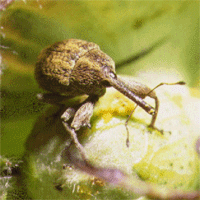Anthonomus grandis
Boll weevils have been declared eradicated in the West Texas region. In 2016, the only zones in the United States to capture weevils were the Lower Rio Grande Valley and South Texas/Winter Garden zones (Fig. 73). Contact your local AgriLife Extension office or the Texas Boll Weevil Eradication Foundation (325-672-2800) for infor- mation.
